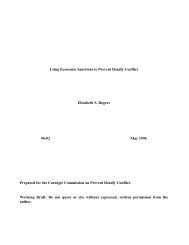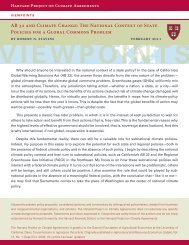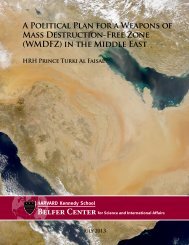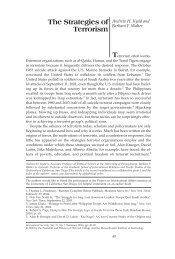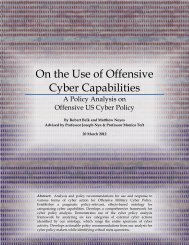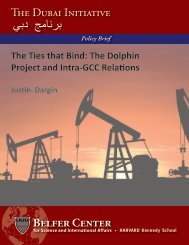Plutonium Mountain - Belfer Center for Science and International ...
Plutonium Mountain - Belfer Center for Science and International ...
Plutonium Mountain - Belfer Center for Science and International ...
- No tags were found...
You also want an ePaper? Increase the reach of your titles
YUMPU automatically turns print PDFs into web optimized ePapers that Google loves.
plutonium chemically from the concrete <strong>and</strong> turn it into metal, which is what is required <strong>for</strong> a<br />
nuclear bomb. The mixture “added suspenders to our belt,” Ristvet said – though only <strong>for</strong> the<br />
Kolba where the cement would actually be inside the canister with the plutonium. 75<br />
The work on the three Kolbas was called Operation Nomad. It was completed by the spring of<br />
2005, nearly a decade after the original “Project Amber” memo. Kutsenko decided it was time<br />
<strong>for</strong> Rosatom to release all the remaining in<strong>for</strong>mation about experiments per<strong>for</strong>med at Degelen<br />
<strong>Mountain</strong>. This was the breakthrough U.S. scientists had long hoped <strong>for</strong>. In preparation, Russian<br />
scientists estimated the amount of material at each experiment site in the tunnels <strong>and</strong> rated the<br />
risk posed by the material.<br />
In April, 2005, Kutsenko <strong>and</strong> Stepanyuk met with Ristvet, Weber <strong>and</strong> Sullivan in Kazakhstan<br />
<strong>and</strong> presented the in<strong>for</strong>mation. The tally wasn’t pretty. Even after Operation Nomad, Degelen<br />
<strong>Mountain</strong> still contained around 100 kilograms of recoverable plutonium—enough <strong>for</strong> more<br />
than one dozen nuclear weapons. 76 The material existed in more Kolbas inside the tunnels, but<br />
also in smaller, less secure “end-boxes,” where experiments with lower explosive yields were<br />
per<strong>for</strong>med.<br />
Operation ‘Golden Eagle’<br />
Then came a surprising revelation. In several of these end-boxes, Russia had left behind not just<br />
material, but highly-sensitive components used to build nuclear weapons. According to Stepanyuk,<br />
the equipment carried “maximum risk.” 77 According to a U.S. official who was involved:<br />
The ‘equipment’ included high-purity plutonium that would have easily provided materials<br />
<strong>and</strong> in<strong>for</strong>mation that could lead to a relatively sophisticated nuclear device. 78<br />
This disclosure alarmed U.S. officials, who decided immediately (with Russian agreement) that<br />
the material should be the first priority in any further work at Degelen <strong>Mountain</strong>. 79 According to<br />
one participant, the admission by the Russians of the high-value sites probably would not have<br />
been possible were it not <strong>for</strong> several years of negotiations <strong>and</strong> ef<strong>for</strong>ts to build trust by U.S. <strong>and</strong><br />
Russian officials. 80 Even so, the Russians were cautious. In their reports to the U.S. side, they<br />
75<br />
Ristvet said he proposed the idea after remembering an article by scientists from Los Alamos <strong>and</strong> Livermore National Laboratory<br />
explaining that reference samples of plutonium stored in steel containers after 25 years of storage had mysteriously reduced<br />
in quantity; the scientists discovered that plutonium was bonding to iron in the walls of the container. “This was my big contribution,<br />
remembering that this bond between iron <strong>and</strong> plutonium wasn’t something that simple acid wash could remove,” Ristvet<br />
says. Scientists interviewed <strong>for</strong> this article were split about the effectiveness of this intervention in preventing the recycling of<br />
plutonium into a bomb, <strong>and</strong> so is the literature. See, <strong>for</strong> example, Los Alamos Scientific Laboratory, “Large Scale Electrorefining<br />
of <strong>Plutonium</strong> from <strong>Plutonium</strong>-Iron Alloys,” Los Alamos, New Mexico, August 1964, http://www.fas.org/sgp/othergov/doe/lanl/<br />
lib-www/la-pubs/00319923.pdf (accessed on March 7, 2013).<br />
76<br />
Stepanyuk, “Liquidation of Consequences.”<br />
77<br />
Stepanyuk, “Liquidation of Consequences.”<br />
78<br />
U.S. official, private communication with the authors.<br />
79<br />
Ristvet said the components would allow terrorists or a rogue regime to “reverse engineer <strong>and</strong> build something extremely<br />
sophisticated.” There is a precedent <strong>for</strong> sensitive components left at a test site. Britain returned to Australia after completing its<br />
testing program at Maralinga to collect several proliferation-sensitive triggering devices used <strong>for</strong> a nuclear bomb. Interview with<br />
Carlson, September 2012.<br />
80<br />
Private correspondence with U.S. official who participated.<br />
30<br />
<strong>Plutonium</strong> <strong>Mountain</strong>: Inside the 17-year mission to secure a dangerous legacy of Soviet nuclear testing



